THE GREENEST BLOCK IN BROOKLYN (1902)
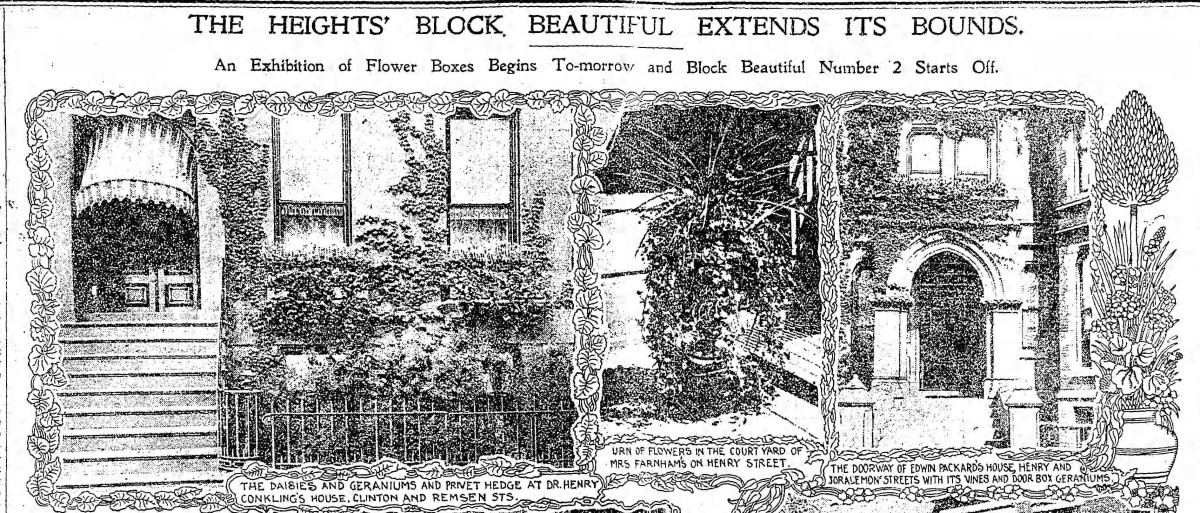
Brownstone Detectives investigates the history of our clients’ homes.
The story you are about to read was composed from research conducted in the course of one of those investigations.
Do you know the history of YOUR house?
********************************************************************************************************************************
As the judging for this year’s “Greenest Block in Brooklyn” award heads into its final round, we bring you a history of the concept of beautifying and greening neighborhoods in the borough of Brooklyn.
A BRIEF HISTORY OF BLOCK BEAUTIFICATION IN BROOKLYN
Before the Botanic Garden arrived on the scene with its “Greenest Block in Brooklyn” initiative in the 1990s, there was “Block Beautiful.”
A number of private Brooklyn citizens, wishing to bring about the greening of their neighborhood, initiated an organized effort to stimulate an active interest in its residents utilizing their green thumbs to good effect.
This earliest organized “block beautification” project began somewhat simultaneously in 1902 on two separate streets and section of the borough – Henry Street (in Brooklyn Heights) and on Quincy Street (in the Bedford Section).
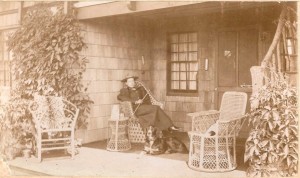
Led by Miss Zella Milhau of 291 Henry Street, the effort was called “Block Beautiful,” and was an initiative to “green” the block upon which she and her family lived, with the hope that this effort would be replicated throughout the city.
Milhau, an artist and active member of the Municipal Art Society and the Fine Arts Club of Manhattan, who lived in the Columbia Heights section on Henry Street between Joralemon and State streets, originated the idea and got the majority of families on her block to follow along.
The Milhaus were “one of the oldest of the Heights families,” noted the Brooklyn Daily Eagle. They had “for generations occupied one of its quaint brick houses.”
The first attempts by this group were with the contracting out of the building of window boxes for flowers, the “setting of shrubs on stoops,” and “for the planting of trees.” There were “six heights householders within the proposed bounds – Henry, Joralemon, Court, and State streets” who would be inaugurating the plan “at once.”
Not everyone would be taking part immediately, though. As this was such a new program, many residents within the boundaries took a more guarded approach, deciding to take a wait-and-see approach. They wondered if the plants and flowers would die, and what cost would be for the planting and the upkeep, along with a host of other concerns.
BLOCK BEAUTIFUL SPREADS TO QUINCY STREET
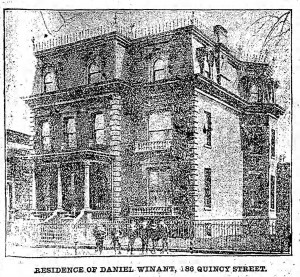
Later in the Spring, influenced by the Heights experiment, another began to flower in the Bedford section of Brooklyn.
At 194 Quincy Street, between Nostrand and Bedford avenues, Mr. and Mrs. W. A. Pothier were the driving force for their block’s first attempts at beautification through greenery.
The Pothiers had a meeting at their house, joined by a number of women on their block, at which Miss Milhau spoke, giving the particulars as to how her block was proceeding with their Bock Beautiful. The following night another meeting took place at which all women and men were invited to view a display of window boxes and baskets.
The result was that on Quincy, 63 “heads of families all living on the single block of Quincy” started a “block association” whose sole purpose was “the improvement and better care of Quincy Street.” Within the space of a year, combined as a group, the block association – not political, although named the “Quincy Street Seventh Election District Association” – achieved a record in Brooklyn for the planting of trees – 63, which amounted to “a tree for each residence.”
A BLOCK IS WHAT YOU MAKE IT
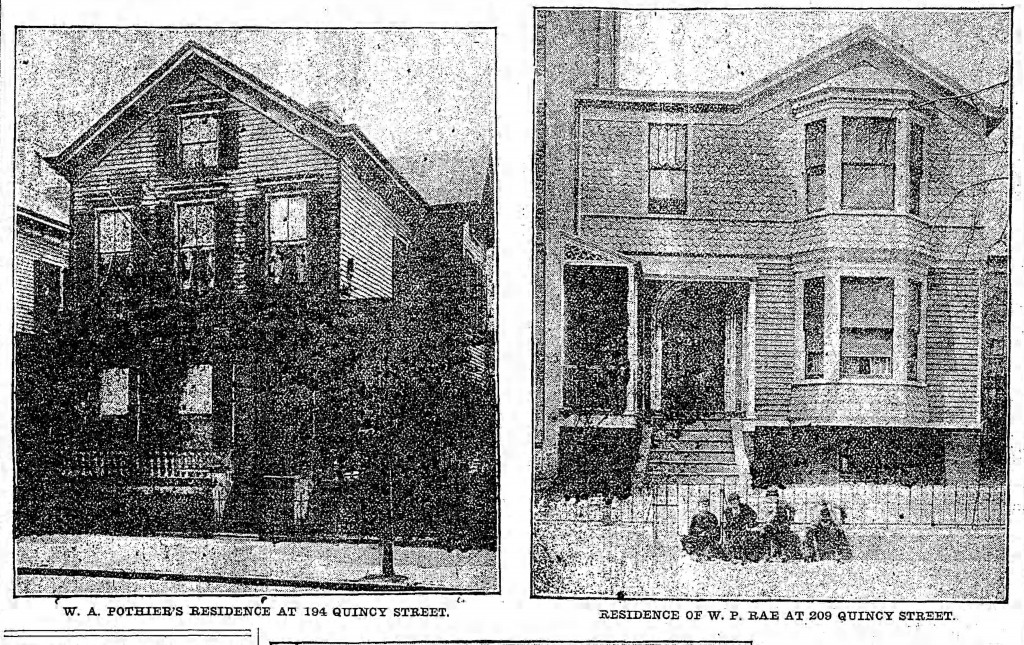
The Brooklyn Daily Eagle noted that their block was “one of the most attractive blocks in the borough as regards cleanliness, shade and carefully kept appearance,” but then went on to note that this was in spite of the fact that it was “not a block of the handsomest residences in the city.
“The houses that line in on either side are of varying types, many detached villa-like homes of wood, several detached, more elaborate houses of brick, several rows of brick and brownstone dwellings of the high stoop variety.”
On the Quincy Street block, though, there seemed to be even more excitement about participating in the program.
Mrs. Manuel Gonzalez of 169 Quincy announced that she would not wait for concerted action, but would at once put put out “every green thing” she had in the house. Since then the Gonzalez stoop has been “a bower of palms in pots. ”

VANDALS ON QUINCY
Even the most positive programs though would have their detractors.
In this case it was “boys.”
One woman on Quincy was concerned about the “periodical raids by boys of the Bedford section.” These young boys, she said, took particular delight in wading through flower gardens and breaking flower pots.
So, the suggestion was made that the boys of Quincy street be organized as a “vigilant committee to protect the flowers from the depredations of outsiders.”
Although a committee of some 15 “enthusiastic” boys was deputized, it is not recorded how that worked.
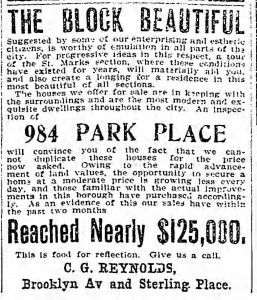
REALTORS CO-OPT THE BLOCK BEAUTIFUL IDEA
It was not too long before realtors selling houses in various area of Brooklyn began to co-opt the idea of better marketing their properties through the use of the popular term, “Block BeautifuL.”
One realtor, in particular, sought to note that the block that he was selling properties on was always a “Block Beautiful” in the best sense of the words.
Also, the Block Beautiful moniker was used by landlords on the block who knew that it would attract potential tenants. The name was prominently displayed at the top of one ad for an apartment for rent on the Quincy Street block.
BROOKLYN BOTANIC GARDENS ENTERS THE PICTURE
Twenty years ago, the Brooklyn Botanic Garden got into the business of bringing their business out onto the streets of Brooklyn with their “Greenest Block of Brooklyn” campaign and contest. Twenty years later the program is going strong and there isn’t a block in Brooklyn that doesn’t know about it.
Twenty years from now, as the concept is a strong and very popular one, block associations in Brooklyn will still be greening their blocks, proving Miss Milhau’s point that the original Block Beautiful, as a sustainable concept, deserves to thrive.
Today, more than 100 years since its inception, Miss Zella Milhau’s point continues to ring true.
———————————————————————————————————————–
 Brownstone Detectives is an historic property research agency. Our mission is to document and save the histories of our clients’ homes. From our research, we produce our celebrated House History Books and House History Reports. Contact us today to begin discovering the history of your home.
Brownstone Detectives is an historic property research agency. Our mission is to document and save the histories of our clients’ homes. From our research, we produce our celebrated House History Books and House History Reports. Contact us today to begin discovering the history of your home.